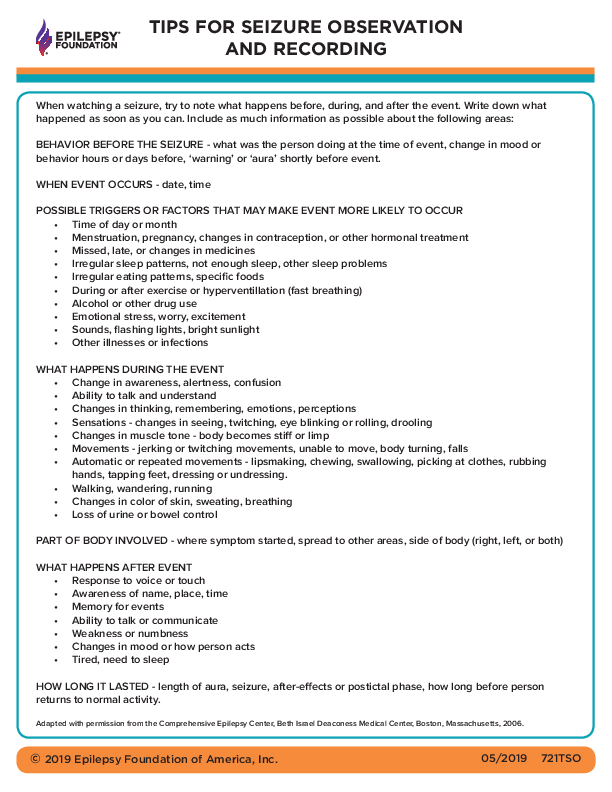Mission & Values
The Epilepsy Foundation, in collaboration with our community and network partners, connects the people, data and resources needed to address challenging health problems associated with seizures and the epilepsies—and promotes education, policy, research and systemic change that will foster measurable and sustainable improvement for all people living with epilepsy.
Read the full 2025 Strategic Plan:
Our Mission
Improve the lives of people affected by epilepsy through education, advocacy, research, and connection.
Our Core Values
Only a small fraction of the 3.4 million Americans affected by the epilepsies are directly engaged with the Foundation network. People with epilepsy continue to experience stigma around the condition, and diminished opportunities for education and employment. Health disparities and unequal access to care plague our systems. Federal funds appropriated for epilepsy research lag in comparison to other diseases with far lower prevalence. After decades of new therapy development, we are still controlling the symptoms – the seizures – without modifying the course of the disease or preventing it from happening in those at risk. Year after year, we continue to see our loved ones with epilepsy suffer in myriad ways. Lost opportunities, injuries, depression, hopelessness. We lose loved ones with epilepsy, sometimes far too early.
The Foundation must rise to meet the serious challenges we face in a new way, with increased focus, greater scale and efficiency, and stronger partnerships with all organizations in the space that are equally committed to improving the lives of people living with the epilepsies. Here, we lay out a plan to harness the power of collaboration for our work over the next five years to End Epilepsy® Together.
Changes at the Epilepsy Foundation
The Epilepsy Foundation has undergone a dramatic transformation this year. As one of the largest and longest-standing non-profit organizations dedicated to improving the lives of people living with epilepsy, the Foundation and its nationwide network has long held a leadership role in advocacy, education, direct services, and research related to epilepsy.
But... we know that the organizational model that has supported our work over the last 52 years is not sufficient to meet today’s challenges, nor will it thrive over the next 50 years of improving the lives of people living with epilepsy. We are currently comprised of a national organization (EFA) which supports a network of local chapter offices and affiliated local 501c3 organizations. We have been in existence since 1968, and yet there are too many examples of where we are falling short of what the epilepsy community deserves.
The Foundation must rise to meet the serious challenges we face in a new way, with increased focus, greater scale and efficiency, and stronger partnerships with all organizations in the space that are equally committed to improving the lives of people living with the epilepsies. Here, we lay out the scope of the challenges, the way we see our new role in the landscape, and our strategic vision for our work over the next five years to End Epilepsy ® Together.
Our Challenges
Epidemiological data indicate that 10% of Americans will suffer a seizure at some point in their lives; 1-2% will have epilepsy. Epilepsy is characterized by re-occurring unprovoked seizures and affects 3.4 million Americans. At least 50% of the total population of individuals with epilepsy will have started having seizures at less than 20 years of age. Compared to the general public, people with epilepsy have higher rates of premature mortality, injury, cognitive impairment, depression, social isolation, and unemployment.
Our scientific understanding of seizures and epilepsy has grown dramatically over the last decades, revealing that epilepsy is not a single disease. Rather, it is a heterogeneous set of disorders with genetic and acquired etiologies better described as “the epilepsies.” There is a wide diversity of seizure types, epilepsy syndromes, outcomes and etiologies. For some, epilepsy is a manageable chronic illness -- affected individuals have risen to the highest echelons of professional success. However, for others, epilepsy is a devastating and progressive disease leading to developmental delay, regression and early death.
Wide variations in epilepsy care delivery and clinical practice may also contribute to poor individual outcomes. Achieving the best possible outcome and highest possible quality of life for every person with epilepsy requires a system with at least four components; high-quality medical care, accessible community services, supportive environments in which to live, learn, work, and play, and an activated individual and family. Unfortunately, today, the health promotion components that support people with epilepsy often do not function as a cohesive system. Healthcare and social support and self-management programs are isolated from each other, making it difficult for anyone to experience truly comprehensive care.
Health disparities create poorer outcomes for some groups within our community, driven in part by social determinants of health. For example, there are racial and ethnic disparities to comprehensive epilepsy care. We know that anyone with a brain can have a seizure or develop epilepsy; the epilepsies affect people of all ages, genders, races, ethnicities, and socioeconomic status. However, the impact of an epilepsy diagnosis is not equal.
Our Strategic Vision for 2020 - 2025
The Foundation’s strategic vision for 2020 – 2025 has five objectives (the ‘Five Pillars’). These Pillars were identified through surveys and collaborative discussions with our stakeholders during 2018 – 2019 and were endorsed by our Board of Directors. They create a bedrock for the structure of our organizational priorities over the next five years.
For each Pillar, the Foundation’s executive staff leadership defined Key Results that will – if achieved over the five years of this plan – demonstrate dramatic progress toward the goal of ending epilepsy together.
In order to achieve the Key Results, staff leadership will identify specific, measurable, organizational priorities for each year of this plan, and will implement those priorities through the work of its cross-functional teams and partnerships. We will measure and report our progress quarterly, seeking to be transparent with our internal teams and external partners, and to adapt strategies as needed to achieve our goals.
The Five Pillars
The Five Pillars represent how we will create positive impact in the world for people with the epilepsies in pursuit of our vision and mission over the next five years.
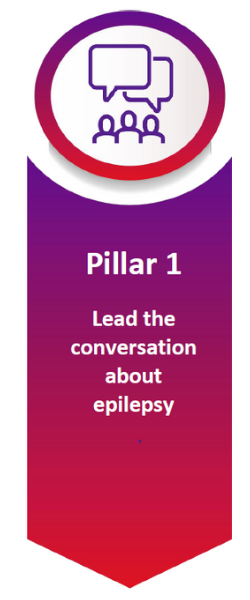
Pillar 1: Leading the Conversation
Inform, inspire, and engage everyone to join the movement.
- We will put the brain and stories of people with epilepsy at the center of the conversation.
- We will ensure that our communication channels provide essential, dynamic and personalized information about seizures and the epilepsies.
- We will use these channels to educate, connect, and inspire the epilepsy community and increase access to information and news about scientific advances.
- We will provide more training for seizure first aid through innovative public and private partnerships.
- We will advocate for legislation to ensure safety, wellness, and access to quality care for people with epilepsy.
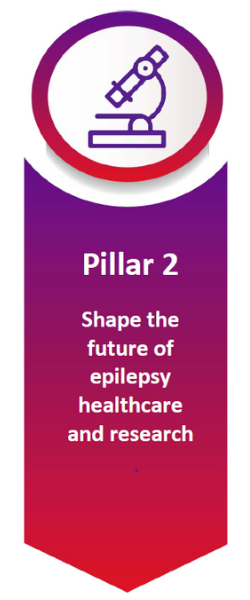
Pillar 2: Shape the Future
Accelerate innovation and partnerships in healthcare and research and improve access and care for all people with the epilepsies.
- We will build partnerships with key epilepsy centers in the US, and with professional organizations representing the healthcare providers who most often treat people with epilepsy.
- We will advocate to ensure that every person with epilepsy has health insurance and/or access to the care they need.
- We will advocate for comprehensive care that treats the whole person, and for behavioral health programs and self-management education.
- We will partner with our community to leverage data to accelerate personalized treatment and individually optimized management to consistently improve outcomes.
- We will invest in and support continuous improvement through the Epilepsy Learning Healthcare System (ELHS).
- We will accelerate innovative epilepsy research in a timeframe that matters.
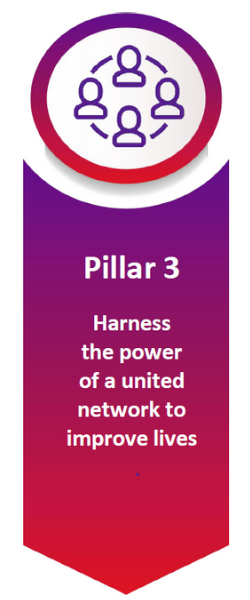
Pillar 3: Harness the Power
Improve the lives of people with the epilepsies by activating the field, volunteers and the broader community with the tools, programs and information they need.
- We will scale up our network’s impact by providing the systems, relationships, tools and information needed to change the lives of greater numbers of people with epilepsy.
- We will grow and sustain a robust volunteer force.
- We will empower volunteer leaders with the right information and infrastructure needed to train and support them.
- We will invest in centralized systems, a unified brand, and best practices across the network for more efficiency and effectiveness at the grassroots level.
- We will drive change through strategic national and local partnerships, to include affiliated and non-affiliated non-profits, corporate sponsors, healthcare organizations and governmental and philanthropic funders.
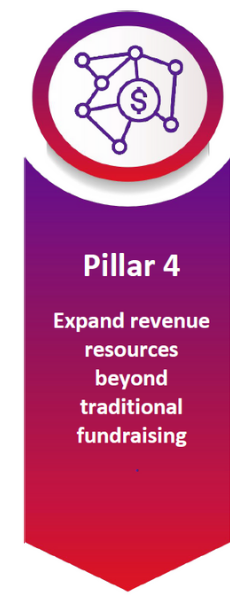
Pillar 4: Expand Revenue Resources
Enable more people affected by the epilepsies to engage with us and benefit from our mission by generating new resources, activating new technology and innovations.
- We will generate the resources needed to reach, support and engage every person living with epilepsy.
- We will create and nurture a fundraising culture to fuel fresh ideas about raising awareness and dollars.
- We will support a robust DIY fundraising platform to drive grassroots funding.
- We will invest in entrepreneurship to bring breakthrough products to life.
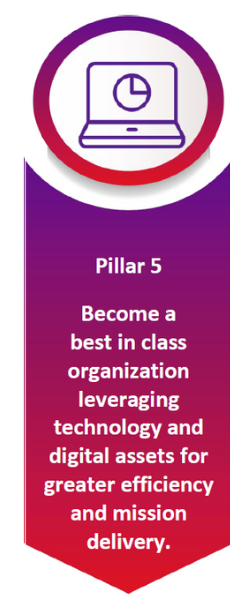
Pillar 5: Become a Best in Class Organization
Improve overall outcomes for people with the epilepsies by developing a data infrastructure and cutting-edge technology that utilizes the data for self-monitoring and management, advancing research, identifying patient cohorts for clinical trials.
- We will create an innovative, collaborative culture of agile leaders. We will attract, develop and retain the best talent and invest in building a culture of innovation, collaboration, excellence and diversity. Our new emerging culture will be informed by data and will share best practices networkwide to level up our performance and impact.
- We will strengthen our ability to fuel a powerful grassroots movement by making sure that we are reaching, serving, and engaging ALL populations, types of epilepsies and communities with equity, fairness, and access to care and information.
- We will invest in new technology and data solutions to get the right information to the right people at the right time. We will apply cutting-edge technology solutions and data strategies that speed access and quality of care, increase education, connect and motivate donors, and inform innovation and research programs.
Organizational Priorities
In each year of this Strategic Plan, the Foundation will identify one or more organization-wide priorities for each of the Pillars. Achieving each organizational priority will culminate in achieving our Key Results for the Strategic Plan. The organizational priorities are intentionally cross-functional, requiring teamwork across the Foundation’s departments and with network partners and volunteers.
We will build Epilepsy Foundation 2025 for maximum impact over the next five years with strategic investments and measured progress on each of these critical building blocks.
Current organizational priorities include the following:
- Seizure Safe Nation
- Epilepsy Learning Healthcare System (ELHS) and Epilepsy Digital Experience Navigator (EDEN)
- Volunteer Force
- Epilepsy Venture Fund
- Epilepsy Digital Engine
Downloadable Strategic Plan
For more information about our 2021-2025 Strategic Plan download the PDF below.
Resources
Epilepsy Centers
Epilepsy centers provide you with a team of specialists to help you diagnose your epilepsy and explore treatment options.
Epilepsy Medication
Find in-depth information on anti-seizure medications so you know what to ask your doctor.
Epilepsy and Seizures 24/7 Helpline
Call our Epilepsy and Seizures 24/7 Helpline and talk with an epilepsy information specialist or submit a question online.
Tools & Resources
Get information, tips, and more to help you manage your epilepsy.

